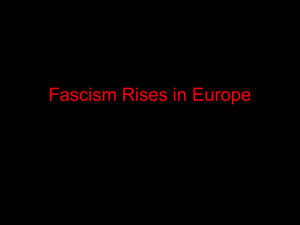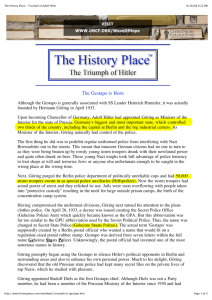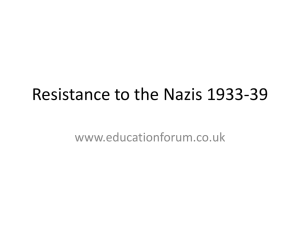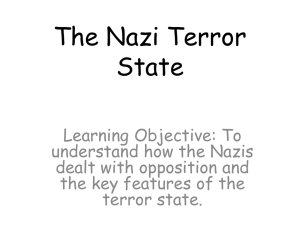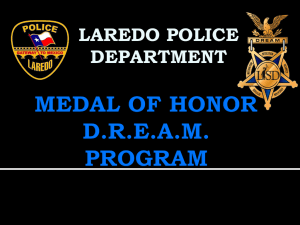File
advertisement
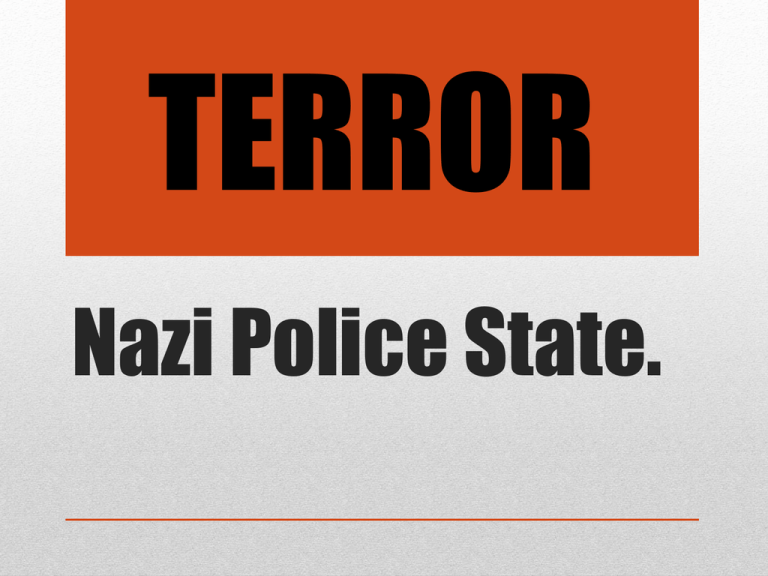
TERROR Nazi Police State. • Until 1933 each state in Germany had its own police force. By 1936 they had been centralised under Himmler as Chief of Police. • The Nazis developed a confusing structure of agencies. • In 1936 Himmler was made Chief of German Police, adding control of the Gestapo to that of the SS and thus reinforcing the overlap. • Kershaw comments on this link “The most powerful agency of repression thus merged with most dynamic ideological force in the Nazi Movement’. • Thus both the SS and the Gestapo can be seen as powerful police forces. The Police in Nazi Germany. • SA disarmed and restructured after the Night of the Long Knives. • SS developed into the main terror instrument of the regime. • The Gestapo. From 1936 it became the most important security agent of the state, able to decide what the law was. • The SD or Security Police was the internal security/intelligence service of the SS, headed by Heydrich; in some way it was the elite of the elite. • The RHSA or Reich Main Security Department, was created in 1939 to group the security services together. How the police were organised? Centre of terror network Failed poultry farmer. Joined the Nazi party in 1923, taking part in Munich Putsch. Himmler believed Hitler was the Messiah, destined to lead Germany to greatness. Hitler, who was always vulnerable to flattery, decided in January, 1929, that Himmler should become the new leader of his personal bodyguard (private army), the Schutz-staffel (SS). Heinrich Himmler In 1936 he was made head of all the police forces in Germany, including the Gestapo. In 1941 he was head of the SS units that ran the slave labour camps and carried out the mass murder of the Jews. December, 1940 Himmler established the Waffen SS. This new army grew rapidly and within six months grew to over 150,000 men. • SS ( Schutz – Staffel ) means protection squad. • They wore a black uniform. • SS were the principal instrument of internal rule in Germany. • By the time the Nazi Party gained power in 1933 Himmler's SS had grown to a strength of 52,000. By 1939 it had 240,000 members. • All recruits had to be vetted by Himmler as recognisably ‘Aryan’ – blond, blue-eyed and physically fit. • SS were trained to be ruthless and very loyal towards Hitler. • The SS were allowed to arrest people without trial and search houses without warrants. The Schutz-Staffel (SS) • On Hitler’s accession to power, the SS was authorised to act as auxiliary police. It used the Emergency Power Decree of February 1933. Which remained permanently in force) to take suspects into ‘protective custody’ and, after the weakening of the SA, the SS emerged as the chief police arm of the Nazi Party. • Between 1933 and 1939 about 225,000 Germans were convicted and imprisoned for political crimes. By 1939 another 162,000 were in ‘protective custody’ without trial. It directed its energies against all enemies of Nazism, whether political or racial, later taking over responsibility for concentration and extermination camps. • By 1939 there were 240,000 members organised into division. The main branch was the Waffen-SS (military), the Death’s Head (Concentration) The Schutz-Staffel (SS) • The Waffen SS was created as the armed wing of the Schutzstaffel (Protective Squadron) and gradually developed into a military force of Nazi Germany. Waffen-SS • • Recruitment Poster 1941. ‘Admission after 17th Birthday’. • “The SS was not merely a police, surveillance, and paramilitary organisation. The main objective, from which it derived its ‘legitimate’ use of force, was to create the racially pure Volksgemeinschaft… The SS evolved from a police organisation operating within an administrative whole to become an independent organisation.. It became the active part of the political community. Making all the decisions of any political importance… Yet the SS did not simply safeguard the new political order; in Himmler’s words,. It was also charged with ‘creating’ the new order. Police power became create power within the Third Reich, its protective role enlarged so as to allow it to make policy beyond the limits of legitimate state activity and to fuse elements of the new racial community together… The police could do anything in the name of Volksgemeinschaft”. • The American historian Sax – How the role of the SS grew 1992. How the SS became so powerful. SS - Uniform Concentration camps were set up in rural areas to imprison political opponents of the Nazis. Inmates were at first held for short periods of questioning, torture and hard labour. Late 1930s saw concentration camps being run by a section of SS called Death’s Head unit. By 1944 there were 13 main concentration camps. In an attempt to increase war-production, inmates were used as cheaplabour. It has been estimated that between 1933 and 1945 a total of 1,600,000 were sent to concentration work camps. Of these, over a million died of a variety of different causes. Concentration Camps • Although distinct organisations they are linked. • Gestapo was a state body. • SS was a party body. • However both groups role was to root out enemies of the state and developing the Nazi racial community. • A historian Kershaw describes the SS as ‘the ideological power house of the Third Reich and executive organ of the ‘Fuhrer will’. Gestapo & the SS – The Link • The Gestapo was the state secret police. • Had a huge network of informers collecting vast amounts of information on people who were thought to be ‘anti – Nazi’ • Telephones were tapped and mail was opened. • The Gestapo would arrest people without trial, torture them and send them off to concentration camps. The Gestapo • • • • • • • • • • • • Murder. Prison. Beatings. Execution. Press Censorship. Dismissed from job. Administrative arrest. Concentration camps. Sterilisation. Warnings. Intimidation. Prison. 1942 – 30,000 Gestapo Officers 1939 – 50,000 SD officers By July 1933 over 26,000 political prisoners. 1933-45 – 800,000 detained for resistance. 1933-9 Courts sentence 225,000 people to total of 600,000 years in prison for political offences. April 1939 – Gestapo claimed that 162,734 people in ‘Protective Custody’… 1933-45 – 32,000 legally executed. 1933-> Concentration Camps, Work Camps, Labour Camp… The Gestapo • Never before in no other land and at no other time, had an organisation attained such a comprehensive penetration of society, possessed such power, and reached such a degree of ‘completeness’ in its ability to arouse terror and horror as well as in its actual effectiveness. – Jacques Delarue 1994. • They [the Gestapo] were everywhere. (An old man from Wurzburg commented). Records show that there were 28 Gestapo officials covering the million people living in Wurzburg… • DO THESE SOURCES AGREE ??? • IN WHAT WAYS DID THE GESTAPO ACHIEVE TERROR. The Gestapo • Police were part of the network of informers as their bosses were all Nazis. • They had to take an oath of loyalty towards the Nazi Party. • Police ignored crimes committed by Nazis. • Each town was split up into small units, each unit was assigned their own warden. • Every house was visited by the warden, collecting donations whilst checking up on everyone. • The warden had to write a report on each person in their block. • The report could of effected a persons employment. • Independent thinking was reported, for example if the Nazi flag wasn't flying on celebration days. Police & Local Wardens

